Game 5 between the New York Rangers and Tampa Bay Lightning was a bit more of a goaltending duel that we had been expecting for this series. A couple screened shots by defencemen Ryan Lindgren and Mikhail Sergachev gave us a 1-1 game heading into the third period as both Andrei Vasilevskiy and Igor Shesterkin were standing tall in net. They both looked like the Vezina-calibre goalies they had been most of the regular season.
Sergachev would give Tampa the lead late in the third period on another screened shot, not long after Ryan Strome whiffed on what was an empty net. Those are the fine margins when we get this late in the playoffs. Brandon Hagel added an empty netter to seal the 3-1 win and the Lightning are now leading the series 3-2 with a home game back in Tampa on Saturday.
Believe it or not, these are the first goals for Sergachev in this playoff run, and the first goal(s) for him in the postseason since Game 5 of the Cup Final back in 2020. He had gone postseason 39 games without a tally, so this was a good time for him to break out.
*
My main focus during the regular season tends to be daily fantasy sports, not so much season-long fantasy. I do both, obviously, but the former takes way more time every day and involves a lot more money being involved.
To that end, I wanted to share this interview with The Athletic's Dom Luszczyszyn. He has a hockey betting model that he's made public, and he is generally a great resource for the analytic side of the game. This is the interview he did with CBC:
Contained in that article is a Twitter thread that he did in the regular season about the ups and downs of sports betting which, by extension, applies to daily fantasy. With legalized betting now a thing in Canada, I cannot urge enough for new bettors to read that thread and watch that interview. It is a very level-headed approach to the realities of the game.
Long and short is this: you'll likely be a losing player. For DFS, the rough number is that a little over 90% of players are losing players long-term. When you're sports betting, or playing DFS, you're either up against Vegas bookmakers, who are very smart, or other DFS players who may do this professionally, or at least semi-professionally, and are also very smart. It's very hard to just jump in, follow your gut, and have sustained success.
Every season, I go through a downturn in DFS. Sometimes it lasts weeks, sometimes it lasts months. I was a profitable player in 2021-22, and have been profitable over the last three seasons, which is why I feel comfortable giving DFS advice. But it's not a smooth road to profitability. Quite literally, two or three nights will make your entire season, and when you get two or three months with sustained losses, it's hard to maintain the long-view perspective.
It is very important to stay disciplined and informed. Search out profitable players (or bettors) that are public with their wins and losses. Don't just run to the first person offering TOP PICKS OF THE DAY!!! thinking you'll be making a fortune. Have a plan of what you can afford to lose, how much you realistically want to win (even just going 2x on your initial deposit over a full season is a wildly successful campaign), and if you aren't making your own model, seek out public-facing people who are transparent with what they do. Sports betting can lead people down a very dark path, and it can happen very quickly. Stay within your means and for all that is holy, stay disciplined and know when to walk away. Good luck.
*
Edmonton made it all the way to the Conference Final for the first time in 16 years only to be bounced in four straight games by Colorado. Considering where a lot of us had them pegged at the start of the regular season, it was a successful season for the Oilers. Once they fired Dave Tippett and moved Jay Woodcroft behind the bench, the team went 26-9-3, the third-best points percentage in the league in that span. They were also top-10 in expected goal share at 5-on-5 (via Natural Stat Trick), which shows they were playing well and not just riding at Connor McDavid scoring binge. It would seem both Alberta teams would be served by sticking with their current coaches.
With Edmonton out of the playoffs, I want to do what I've been doing with all the eliminated playoff teams, and that's taking stock of where the franchise is. This, of course, will be with a fantasy hockey slant, and this is a very important franchise to discuss from that perspective. We will look at how certain players performed, the work the team has to do on the roster this offseason, and what the fantasy upside could be from their forwards, defencemen, and goaltending situation. We will be grabbing our data from the aforementioned NST as well as our own Frozen Tools. Visuals will be discussed as necessary, and cap information is from Cap Friendly.
Let's start with one of the most interesting players in the league.
Jesse Puljujärvi
On the whole, it was a good season for the winger, comparing to his prior campaigns. He set a career-best in points (36 in 65 games) and a career-best in TOI with 16:14 a night. But it was a tale of two seasons: 10 goals and 23 points in 29 games, skating 17:18 per game, through the end of December, then 4 goals and 13 points over his final 36 games, skating 15:23 a night. That TOI was even lower under Jay Woodcroft, dipping under 15 minutes a night. The overarching problem was his shooting percentage, managing just a 5% clip in that 36-game sample, and 8.8% on the season. It is a problem that has persisted most of his career: excluding the COVID-shortened season, he's shot 7.1% in 204 regular season games. Even with that season, he's still sitting at 9.1% for his career. Per Hockey Viz, he has one of the worst shooting impacts in the league. This is where he took most of his shots from, and considering how close he gets to the net, that shooting percentage is almost unbelievable:

This isn't a function of playing down the lineup, either. He had roughly 929 5-on-5 minutes and two-thirds of them were skating with McDavid. When they were on the ice together, the team shot 7.6%, whereas that was north of 9% when McDavid was on the ice without him. Their goal-scoring rates were still strong because they generated a lot more shots, and volume matters. But the wrinkle here was adding Evander Kane to the lineup, and he & McDavid had a on-ice shooting percentage over 10.6%. When that dichotomy presents itself, it just shows how poor Puljujärvi's finishing actually was.
This is where we look for a comparison, and the one that comes to mind immediately is Valeri Nichushkin. Yesterday, I compared his 2021-22 season to Artturi Lehkonen's, but Pulju is much more apt. As far as play-driving offensively and defensively are concerned, this is how the Finn and the Russian compared this campaign, from Evolving Hockey:
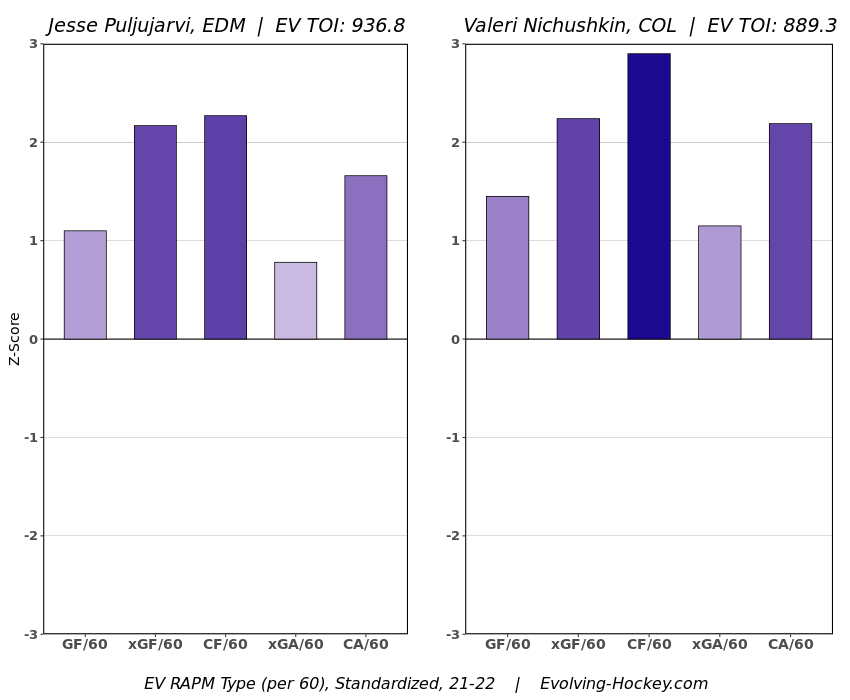
League-wide, the Oilers winger's expected goal differential was top-20 among all forwards, just ahead of names like Aleksander Barkov and Johnny Gaudreau. He is great off the rush, is strong in the defensive zone, and is passable in transition. He just has real trouble finishing, and he's not a great playmaker. The contrasts are stark, as shown by the micro-stats tracked by Corey Sznajder. He shoots a lot (and gets close to the net when he does, which is usually good for percentages), he covers his own end well, but there are a few glaring holes in his game, like high-danger passes in all forms, and a few struggles in zone entries:
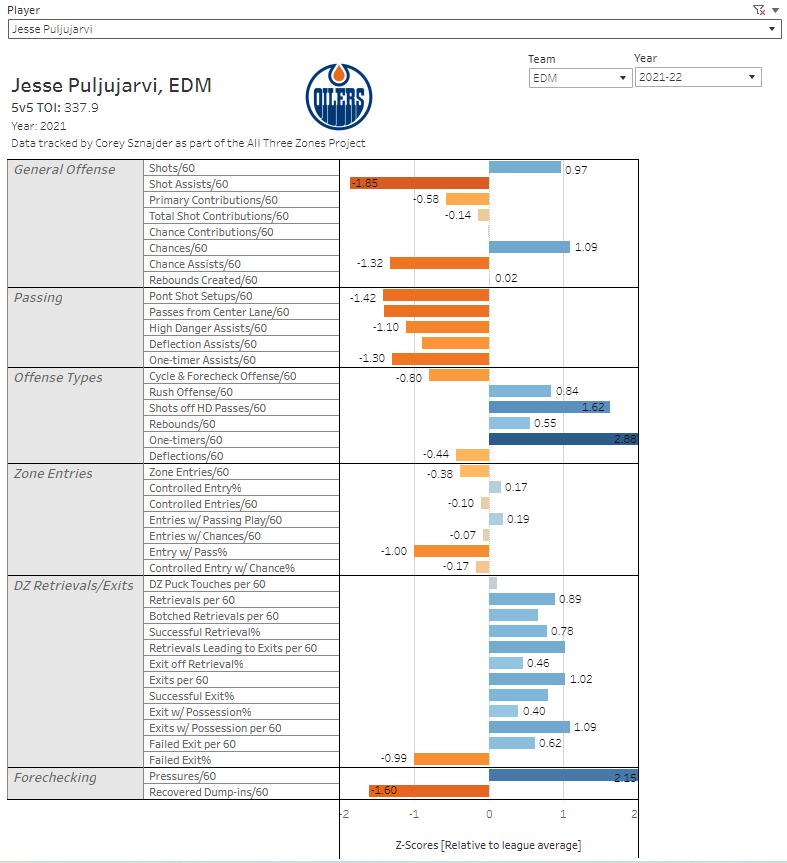
Now, playing with McDavid will take the pressure off things like elite playmaking or transition work; he's not doing the heavy lifting in that combination. It would help explain, to some extent, why the team didn't have a high shooting percentage with him on the ice. This isn't new, either, as the same issues plagued him in COVID 2021.
But Nichushkin had some of the same problems. In his last full season with Dallas, his shot-assist rate was in the middle of the league and his controlled zone entry rate was in the 45th percentile. And by the end of his age-23 season, his last with the Stars, he was shooting 6.8% overall with 223 games under his belt. Pulju just finished his age-23 season and has 259 regular season games under his belt. There is a reason this comparison is being made.
All of this hinges on the big Swede starting to finish. He doesn't have to be 14-15% like Kane was, but being below double digits while skating primarily with the best player in the world is unacceptable. In his role, he doesn't have to be an elite playmaker, but shooting under 9% won't fly. If that shooting percentage turns around, and he can regularly post 25-goal seasons, with that elite defensive play, he'd be a sure-fire first-line winger.
So, we're down to what the team wants to do with him. Both he and Kailer Yamamoto are restricted free agents while Evander Kane and Mikko Koskinen are unrestricted. Bringing back the three forwards and signing a competent backup will, comfortably, cost them $15M against the cap. The team has $7.1M in cap space to work with. They have important decisions to make, and it's not guaranteed the 24-year-old winger (turned 24 in May) will return to the Oilers. If he doesn't, it's hard to see him landing in a better spot than "spends two-thirds of his TOI with Connor McDavid." In that sense, there's no certainty that his shooting problems turn themselves around.
We know McDavid and Leon Draisaitl will get their points. That isn't the concern, from a fantasy perspective. The issue right now is we don't know what that top-6 will look like. Three of their four top-6 forwards need a new contract and they'll be in tough to bring them all back. They could try to extend Puljujärvi and Yamamoto on bridge deals, keeping the AAV down, letting Kane walk, and inserting Dylan Holloway into the top-6. It would largely keep their scoring lines intact, but then they're letting a potential 40-goal scorer walk out the door (off-ice issues aside). Or they could sign Kane long-term, trade the RFA wingers, and really shake things up. It'll be a fascinating summer from the Oilers, from that perspective.
There is also the question of the blue line. Remember Oskar Klefbom? Yeah, he's still under contract for a year. The bad news is that GM Ken Holland didn't seem optimistic that Klefbom will be playing again, as of a couple days ago. Brett Kulak and Kris Russell are UFAs, but they have six defencemen under contract for next season, including prospect Philip Broberg. Kulak shouldn't cost much if they want to re-sign him and they could just bring back mostly the same defence group, with Broberg added to the mix. The defence wasn't really the problem with this team, aside from some miscues at times from the elder guys. Evan Bouchard taking a Quinn Hughes-esque leap offensively would go a long way to replacing what they lost in Klefbom, and he seems on the verge of doing just that. He was among the most impactful defencemen offensively this year, though he seems to still be taking too many shots from the point. If you shoot 10%+ like Cale Makar has for his career, you can do that. If you're under 6%, the returns start to diminish. It's not conjecture, either, we just need to look at the shot map when Bouchard is on the ice (again from Hockey Viz):

Yes, there is a good amount from the front of the net, as anyone who skates 60% of his time with at least one of McDavid and Draisaitl should. The problem is when he's on the ice without them, those slot shots dry up considerably, and he's just firing from the blue line:
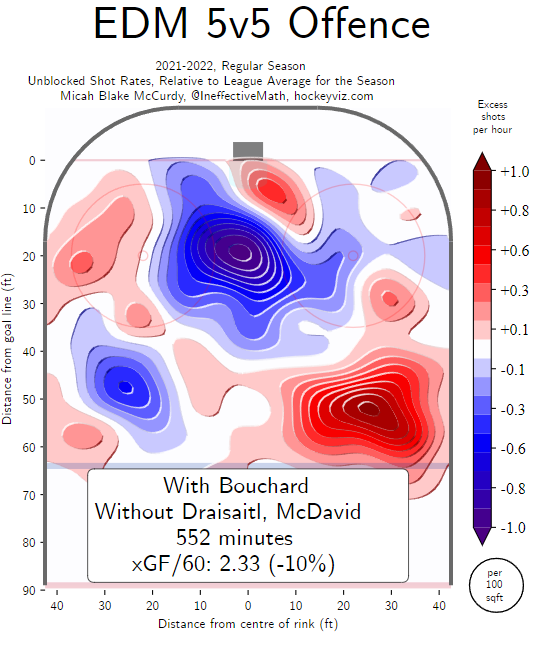
There are reasons why the team shoots just 5.8% with Bouchard on the ice without McDavid and Draisaitl, and that's one of them. The other is lack of scoring depth. To whit, here are how some top teams perform without their top-2 centres on the ice at 5-on-5:
- Colorado: 2.3 goals/60
- Toronto: 2.5 goals/60
- Tampa Bay: 2.2 goals/60
- Calgary: 2.2 goals/60
- Edmonton: 2.1 goals/60
If we include Ryan Nugent-Hopkins in the Edmonton mix, because he, Connor, and Leon did often skate in the top-6 together, that drops to 1.9 goals/60. Depth production continues to be an issue, and if they have to let a winger or two walk this summer, things could get worse.
The Oilers are up against it this summer. They have hard decisions to make, and it's difficult to see this roster being as deep in 2022-23 as it was in 2021-22 unless guys like Broberg and Holloway make significant, immediate impacts. As mentioned earlier, skaters like McDavid and Draisaitl aren't fantasy concerns, and maybe not even Bouchard, as long as he's running the top PP unit, or Zach Hyman, as he should see a similar role next season. But the top-6 forward composition will change, and they don't have the cap space to rebuild their third and fourth lines. It will be fascinating to see what happens with Pulju because he's just some shooting improvement away from being a top two-way winger in the league, and that is something he can work on. It's hard to bet on it until we see it consistently, though.
One Comment
Leave A Comment
You must be logged in to post a comment.


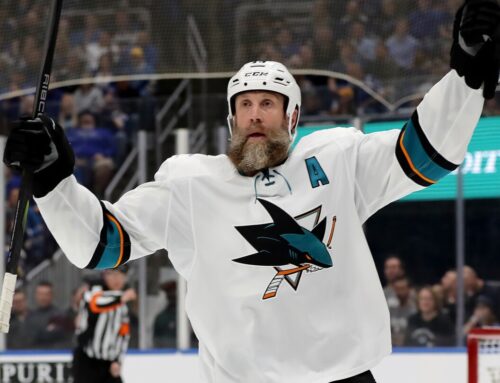

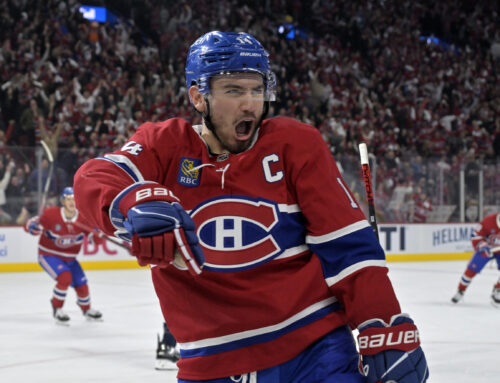
 VAN
VAN UTA
UTA BUF
BUF NYI
NYI WSH
WSH MIN
MIN FLA
FLA ANA
ANA NYR
NYR

FYI… the big Swede is actually Finnish.